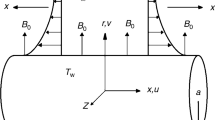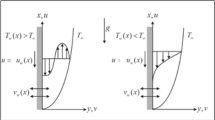Abstract
The current article deals with a novel idea of a suspension of spherical silver \(\left( {{\text{Ag}}} \right)\), cylindrical aluminium oxide \(\left( {{\text{Al}}_{{2}} {\text{O}}_{{3}} } \right)\) and platelet aluminium \(\left( {{\text{Al}}} \right)\) nanoparticles in water–ethylene glycol as a conducting fluid through a convective stretching surface. The effects of induced magnetic field, heat sink or source, thermal radiation and slip condition aspect are also incorporated during ternary hybrid nanofluid flow. The significance of the current investigation lies in enhancing heat transfer efficiencies, high-temperature processes, electronic devices where heat is generated or cooling systems and metal casting. The numerical solutions of nonlinear ordinary differential are obtained by employing a finite difference approach via the bvp4c solver (MATLAB package). The obtained results pointed out that the spherical silver nanoparticles provide a higher rate of heat transfer followed by cylindrical alumina nanoparticles and platelet aluminium nanoparticles, respectively. Moreover, the velocity profile and induced magnetic profile decrease with increasing volume fraction of spherical \({\text{Ag}}\) nanoparticles, cylindrical \({\text{Al}}_{{2}} {\text{O}}_{{3}}\) alumina nanoparticles, platelet \(\text{Al}\) nanoparticles and induced magnetic parameter. The ternary hybrid nanofluid's heat transfer rate is greatly increased by larger values of the radiative parameter, Biot number and slip parameter. Additionally, the temperature profile is improved when the heat source parameter grows while the heat sink parameter decreases.















Similar content being viewed by others
Abbreviations
- \(u,v\) :
-
Velocity component (\({\text{ms}}^{-1})\)
- \(a\& c\) :
-
Stretching rate (\({\text{s}}^{-1})\)
- \(T\) :
-
Temperature of the fluid (K)
- \(T_{{\text{w}}}\) :
-
Temperature at the wall
- \(T_{\infty }\) :
-
Ambient temperature of the fluid
- \(M_{0}\) :
-
Magnetic per unit length (\({\text{Tm}}^{-1})\)
- \(\mu_{{\text{e}}}\) :
-
Magnetic permeability (\({\text{Hm}}^{-1})\)
- \(\pi\) :
-
Magnetic flux density-related coefficient (\({\text{H}}\left( {{\text{sT}}} \right)^{2} \;{\text{kg}}^{-1})\)
- \(\alpha_{{\text{m}}}\) :
-
Magnetic diffusivity (\({\text{m}}^{2} {\text{s}}^{-1})\)
- \(\alpha_{{\text{f}}}\) :
-
Thermal diffusivity (\({\text{m}}^{2} {\text{s}}^{-1})\)
- \(Q_{0}\) :
-
Volumetric heat source/sink coefficient
- \(C_{{\text{p}}}\) :
-
Specific heat at constant temperature (\({\text{JK}}^{-1} {\text{kg}}^{ - 1})\)
- \(\left( {\rho C_{{\text{p}}} } \right)\) :
-
Heat capacity
- \(h_{{\text{f}}}\) :
-
Heat transfer coefficient (\({\text{Wm}}^{-2} {\text{ K}}^{ - 1})\)
- \(\mu\) :
-
Dynamic viscosity (\({\text{kgm}}^{-1} {\text{ s}}^{ - 1})\)
- \(\upsilon\) :
-
Kinematic viscosity (\({\text{m}}^{2} {\text{s}}^{-1})\)
- \(\rho\) :
-
Density (\({\text{kgm}}^{-3})\)
- \(\kappa\) :
-
Thermal conductivity (\({\text{Wm}}^{-1} {\text{ K}}^{ - 1})\)
- \(\eta\) :
-
Dimensionless distance
- \(f\) :
-
Dimensionless transverse velocity
- \(g\) :
-
Dimensionless-induced magnetic field transverse velocity
- \(\theta\) :
-
Dimensionless temperature
- \(f^{\prime} = \frac{\partial f}{{\partial \eta }}\) :
-
Dimensionless main velocity
- \(f^{{\prime\prime}} = \frac{{\partial^{2} f}}{{\partial \eta^{2} }}\) :
-
Dimensionless shear stress
- \(g^{\prime} = \frac{\partial g}{{\partial \eta }}\) :
-
Dimensionless-induced magnetic field along main velocity
- \(\text{f}\) :
-
Base fluid
- \(\text{nf1}, \, \text{nf2}, \, \text{nf3}\) :
-
Nanoparticles
- \(\text{Thnf}\) :
-
Ternary hybrid nanofluid
References
Choi SUS. Enhancing thermal conductivity of fluids with nanoparticles in developments and application of non-Newtonian flows. New York: ASME; 1995. p. 99–105.
Alhadhrami A, Alzahrani HAH, Kumar RN, Gowda RJP, Sarada K, Prasanna BM, Madhukesh JK, Madhukeshwara N. Impact of thermophoretic particle deposition on Glauert wall jet slip flow of nanofluid. Case Stud Therm Eng. 2021;28:101404. https://doi.org/10.1016/j.csite.2021.101404.
Gowda RJP, Sarris IE, Kumar RN, Kumar R, Prasannakumara BC. A three-dimensional non-Newtonian magnetic fluid flow induced due to stretching of the flat surface with chemical reaction. J Heat Transf. 2022;144:113602. https://doi.org/10.1115/1.4055373.
Baithalu R, Mishra SR. On optimizing shear rate analysis for the water-based CNT micropolar nanofluids via an elongating surface: response surface methodology combined with ANOVA test. J Therm Anal Calorim. 2023;148:14275–94. https://doi.org/10.1007/s10973-023-12567-6.
Baithalu R, Mishra SR. Enhanced heat transfer rate analysis with inertial drag effect in a micropolar nanofluid flow within a channel: response surface methodology. J Therm Anal Calorim. 2023;148:12159–73. https://doi.org/10.1007/s10973-023-12483-9.
Baithalu R, Mishra SR, Pattnaik PK, Panda S. Optimizing shear and couple stress analysis for the magneto-micropolar dissipative nanofluid flow toward an elongating surface: a comprehensive RSM-ANOVA investigation. J Therm Anal Calorim. 2023. https://doi.org/10.1007/s10973-023-12741-w.
Siddiqa S, Begum N, Hossain MA, Gorla RSR. Numerical solutions of natural convection flow of a dusty nanofluid about a vertical wavy truncated cone. J Heat Transf. 2017;139:022503. https://doi.org/10.1115/1.4034815.
Srilatha P, Khan MJU, Kumar RN, Gowda RJP, Ahmed SB, Kumar R. Heat transfer analysis in magnetohydrodynamic nanofluid flow induced by a rotating rough disk with non-Fourier heat flux: aspects of modified Maxwell-Bruggeman and Krieger-Dougherty models. Nanoscale Adv. 2023;5:5941–51. https://doi.org/10.1039/d3na00711a.
Gandhi R, Sharma BK, Khanduri U. Electromagnetohydrodynamics Casson pulsatile nanofluid flow through a bifurcated stenosed artery: Magnetically targeted drug delivery. J Appl Phys. 2023;134:184701. https://doi.org/10.1063/5.0172553.
Baithalu R, Mishra SR, Shah NA. Sensitivity analysis of various factors on the micropolar hybrid nanofluid flow with optimized heat transfer rate using response surface methodology: a statistical approach. Phys Fluids. 2023;35:102016. https://doi.org/10.1063/5.0171265.
Timofeeva EV, Routbort JL, Singh D, Wingenfeld P, Gmünd S. Particle shape effects on thermophysical properties of alumina nanofluids. J Appl Phys. 2009;106:14304. https://doi.org/10.1063/1.3155999.
Abbasi M, Heyhat MM, Rajabpour A. Study of the effects of particle shape and base fluid type on density of nanofluids using ternary mixture formula: a molecular dynamics simulation. J Mol Liq. 2020;305:112831. https://doi.org/10.1016/j.molliq.2020.112831.
Sarangi MK, Thatoi DN, Nayak MK, Prakash J, Ramesh K, Azam M. Rotational flow and thermal behavior of ternary hybrid nanomaterials at small and high Prandtl numbers. Int Commun Heat Mass Transf. 2022;138:106337. https://doi.org/10.1016/j.icheatmasstransfer.2022.106337.
Munawar S, Saleem N. Mixed convective cilia triggered stream of magneto ternary nanofluid through elastic electroosmotic pump: a comparative entropic analysis. J Mol Liq. 2022;352:118662. https://doi.org/10.1016/j.molliq.2022.118662.
Gandhi R, Sharma BK, Al-Mdallal QM, Mittal HVR. Entropy generation and shape effects analysis of hybrid nanoparticles (/blood) mediated blood flow through a time-variant multi-stenotic artery. Int J Thermofluids. 2023;18:100336. https://doi.org/10.1016/j.ijft.2023.100336.
Ahmed SE, Raizah Z, Arafa AAM, Hussein SA. FEM treatments for MHD highly mixed convection flow within partially heated double-lid driven odd-shaped enclosures using ternary composition nanofluids. Int Commun Heat Mass Transf. 2023;145:106854. https://doi.org/10.1016/j.icheatmasstransfer.2023.106854.
Shamshuddin MD, Akkurt N, Saeed A, Kumam P. Radiation mechanism on dissipative ternary hybrid nanoliquid flow through rotating disk encountered by Hall currents: HAM solution. Alex Eng J. 2023;65:543–59. https://doi.org/10.1016/j.aej.2022.10.021.
Prakasha DG, Sudharani MVVNL, Kumar KG, Chamkha AJ. Comparative study of hybrid (graphene/magnesium oxide) and ternary hybrid (graphene/zirconium oxide/magnesium oxide) nanomaterials over a moving plate. Int Commun Heat Mass Transf. 2023;140:106557. https://doi.org/10.1016/j.icheatmasstransfer.2022.106557.
Sharma BK, Gandhi R. Entropy-driven optimization of radiative Jeffrey tetrahybrid nanofluid flow through a stenosed bifurcated artery with Hall effects. Phys Fluids. 2023;35:121903. https://doi.org/10.1063/5.0179798.
Pantokratoras A. Comment on “combined heat and mass transfer by laminar mixed convection flow from a vertical surface with induced magnetic field [j. Appl. Phys. 99, 034901 (2006)]”. J Appl Phys. 2007;102:076113. https://doi.org/10.1063/1.2796152.
Sheikholeslami M, Rokni HB. Nanofluid two phase model analysis in existence of induced magnetic field. Int J Heat Mass Transf. 2017;107:288–99. https://doi.org/10.1016/j.ijheatmasstransfer.2016.10.130.
Khan MI, et al. Physical aspects of CNTs and induced magnetic flux in stagnation point flow with quartic chemical reaction. Int J Heat Mass Transf. 2019;135:561–8. https://doi.org/10.1016/j.ijheatmasstransfer.2019.01.141.
Amjad M, Zehra I, Nadeem S, Abbas N, Saleem A, Issakhov A. Influence of Lorentz force and induced magnetic field effects on Casson micropolar nanofluid flow over a permeable curved stretching/shrinking surface under the stagnation region. Surf Interfaces. 2020;21:100766. https://doi.org/10.1016/j.surfin.2020.100766.
Mathew A, Areekara S, Sabu AS, Saleem S. Significance of multiple slip and nanoparticle shape on stagnation point flow of silver-blood nanofluid in the presence of induced magnetic field. Surf Interfaces. 2021;25:101267. https://doi.org/10.1016/j.surfin.2021.101267.
Animasaun IL, Yook SJ, Muhammad T, Mathew A. Dynamics of ternary-hybrid nanofluid subject to magnetic flux density and heat source or sink on a convectively heated surface. Surf Interfaces. 2022;28:101654. https://doi.org/10.1016/j.surfin.2021.101654.
Sharma BK, Kumawat C. Impact of temperature dependent viscosity and thermal conductivity on MHD blood flow through a stretching surface with ohmic effect and chemical reaction. Nonlinear Eng. 2021;10:255–71. https://doi.org/10.1515/nleng-2021-0020.
Sharma BK, Gandhi R. Combined effects of Joule heating and nonuniform heat source/sink on unsteady MHD mixed convective flow over a vertical stretching surface embedded in a Darcy-Forchheimer porous medium. Propul Power Res. 2022;11:276–92. https://doi.org/10.1016/j.jppr.2022.06.001.
Sharma PK, Sharma BK, Mishra NK, Rajesh H. Impact of Arrhenius activation energy on MHD nanofluid flow past a stretching sheet with exponential heat source: a modified Buongiorno’s model approach. Int J Mod Phys B. 2023;37:2350284. https://doi.org/10.1142/S0217979223502843.
Baithalu R, Mishra SR. Response surface methodology in optimizing heat transfer rate for homogeneous–heterogeneous reactions with thermal radiation effect on the micropolar nanofluid. Numer Heat Transf A. 2023. https://doi.org/10.1080/10407782.2023.2282152.
Sharma BK, Khanduri U, Mishra NK, Mekheimer KS. Combined effect of thermophoresis and Brownian motion on MHD mixed convective flow over an inclined stretching surface with radiation and chemical reaction. Int J Mod Phys B. 2023;37:2350095. https://doi.org/10.1142/S0217979223500959.
Sharma BK, Kumar A, Gandhi R, Bhatti MM, Mishra NK. Entropy generation and thermal radiation analysis of EMHD Jeffrey nanofluid flow: applications in solar energy. Nanomaterials. 2023;13:544. https://doi.org/10.3390/nano13030544.
Megahed AM. Variable fluid properties and variable heat flux effects on the flow and heat transfer in a non-Newtonian Maxwell fluid over an unsteady stretching sheet with slip velocity. Chin Phys B. 2013;22:094701. https://doi.org/10.1088/1674-1056/22/9/094701.
Sk MT, Das K, Kundu PK. Multiple slip effects on bioconvection of nanofluid flow containing gyrotactic microorganisms and nanoparticles. J Mol Liq. 2016;220:518–26. https://doi.org/10.1016/j.molliq.2016.04.097.
Fatunmbi EO, Ogunseye HA, Sibanda P. Magnetohydrodynamic micropolar fluid flow in a porous medium with multiple slip conditions. Int Commun Heat Mass Transf. 2020;115:104577. https://doi.org/10.1016/j.icheatmasstransfer.2020.104577.
Reddy NN, Reddy YD, Rao VS, Goud BS, Nisar KS. Multiple slip effects on steady MHD flow past a non-isothermal stretching surface in presence of Soret, Dufour with suction/injection. Int Commun Heat Mass Transf. 2022;134:106024. https://doi.org/10.1016/j.icheatmasstransfer.2022.106024.
Hayat T, Nadeem S, Khan AU. Rotating flow of hybrid nanofluid with radiation and partial slip boundary effects. Eur Phys J E. 2018;41:75. https://doi.org/10.1140/epje/i2018-11682-y.
Kumar B, Seth GS, Nandkeolyar R, Chamkha AJ. Outlining the impact of induced magnetic field and thermal radiation on magneto-convection flow of dissipative fluid. Int J Therm Sci. 2019;146:106101. https://doi.org/10.1016/j.ijthermalsci.2019.106101.
Hafeez MB, Krawczuk M, Nisar KS, Jamshed W, Pasha AA. A finite element analysis of thermal energy inclination based on ternary hybrid nanoparticles influenced by induced magnetic field. Int Commun Heat Mass Transf. 2022;135:106074. https://doi.org/10.1016/j.icheatmasstransfer.2022.106074.
Cao W, Animasaun IL, Yook SJ, Oladipupo VA, Ji X. Simulation of the dynamics of colloidal mixture of water with various nanoparticles at different levels of partial slip: ternary-hybrid nanofluid. Int Commun Heat Mass Transf. 2022;135:106069. https://doi.org/10.1016/j.icheatmasstransfer.2022.106069.
Dolui S, Bhaumik B, De S. Combined effect of induced magnetic field and thermal radiation on ternary hybrid nanofluid flow through an inclined catheterized artery with multiple stenosis. Chem Phys Lett. 2023;811:140209. https://doi.org/10.1016/j.cplett.2022.140209.
Meenakumari R, Lakshminarayana P, Vajravelu K. Influence of induced magnetic field and slip conditions on convective Prandtl fluid flow over a stretching surface with homogeneous and heterogeneous reactions. Multidiscip Model Mater Struct. 2021;17:127–47. https://doi.org/10.1108/MMMS-02-2020-0040.
Elnaqeeb T, Animasaun IL, Nehad AS. Ternary-hybrid nanofluids: significance of suction and dual-stretching on three-dimensional flow of water conveying nanoparticles with various shapes and densities. Z Fur Naturforsch A. 2021;76:231–43. https://doi.org/10.1515/zna-2020-0317.
Das S, Mahato N, Ali A, Jana RN. Dynamical behaviour of magneto-copper titania/water-ethylene glycol stream inside a gyrating channel. Chem Phys Lett. 2022;793:139476. https://doi.org/10.1016/j.cplett.2022.139476.
Mackolil J, Mahanthesh B. Inclined magnetic field and nanoparticle aggregation effects on thermal Marangoni convection in nanoliquid: a sensitivity analysis. Chinese J Phys. 2021;69:24–7. https://doi.org/10.1016/j.cjph.2020.11.006.
Jama M, Singh T, Gamaleldin SM, Koc M, Samara A, Isaifan RJ, Atieh MA. Critical review on nanofluids: preparation, characterization, and applications. J Nanomater. 2016;2016:6717624. https://doi.org/10.1155/2016/6717624.
Author information
Authors and Affiliations
Corresponding author
Additional information
Publisher's Note
Springer Nature remains neutral with regard to jurisdictional claims in published maps and institutional affiliations.
Rights and permissions
Springer Nature or its licensor (e.g. a society or other partner) holds exclusive rights to this article under a publishing agreement with the author(s) or other rightsholder(s); author self-archiving of the accepted manuscript version of this article is solely governed by the terms of such publishing agreement and applicable law.
About this article
Cite this article
Sharma, R.P., Badak, K. Heat transport of radiative ternary hybrid nanofluid over a convective stretching sheet with induced magnetic field and heat source/sink. J Therm Anal Calorim (2024). https://doi.org/10.1007/s10973-024-12979-y
Received:
Accepted:
Published:
DOI: https://doi.org/10.1007/s10973-024-12979-y




